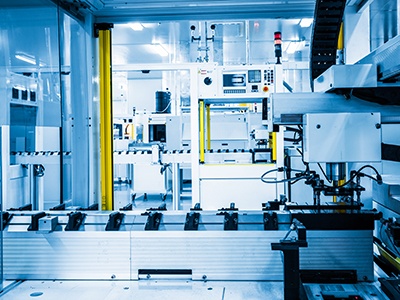
Industrial automation is a complex and mammoth topic covering areas ranging from simple control systems handling processes and machines, through to digital manufacturing, the much-hyped "smart factory" and Industrie 4.0.
In a nutshell, industrial automation is a step beyond mechanisation; it is about using control systems and technology to replace human physical and mental labour in the manufacturing and engineering sector.
Products and systems that combine mechanics, hydraulics, pneumatics, plus electrical and electronic components, can be used to automate tasks previously carried out by humans. These are just some of the technologies that are paving the way for the next industrial revolution: Industrie 4.0, an initiative to revolutionise manufacturing and engineering by combining the digital world and that of industrial production to create "smart" manufacturing facilities.
The term Industrie 4.0 was initially used as a reference to one of ten "future projects" included in the German government’s High-Tech Strategy 2020 Action Plan back in 2012. Industrial automation is used across a wide spectrum of sectors, from the automotive and aerospace industries; to the FMCG and oil and gas industries – to name but a few. In this blog post, we will consider four of the resulting benefits for electronics manufacturers.
1. Increased productivity and efficiency
Human labour comes with an inherent margin of error and, while machines are not fail-proof, they are less prone to make mistakes. For instance, computers don’t get tired or distracted by personal problems. Of course, a machine can’t match human creativity and skill but when it comes to repetitive work, it can get more done, in less time - and more precisely.
Therefore, automation is typically employed in situations where a high degree of accuracy is needed; where the work is physically demanding or taking place within dangerous environments; where monotony occurs.
2. Improved quality
It follows that if the basics of the electronics manufacturing process can be carried out more quickly, then more time can be devoted to the complexities. Speaking to The Manufacturer, Asif Moghal, manufacturing industry manager, Autodesk, says: "Robotics takes basic tasks away, enabling us to focus on higher value activities. The workshops of the future will be highly automated; the human difference is innovation and skills."
With the basic tasks covered, automation frees up more time to focus on other details; the finishing touches, so to speak. This results in inherently higher quality products.
Struggling to consistently deliver quality products to your customers? Download our eBook now for best practice advice:
3. More opportunities for customisation
More and more customers are requesting personalised and customised products to meet the needs of their particular markets. Therefore, manufacturers need to be able to meet these demands without losing money – while still adhering to strict quality and safety standards.
"Smart factories" will enable manufactures to increase flexibility in production. By increasing automation through the use of sensors and configurable robots on the assembly line, they will be able to mass produce items built to individual customer orders and specifications. In the automotive industry, buyers have long been able to "build" their new car on-line and choose from a variety of options to suit their style and taste. However, this has not been the case in other sectors, such as consumer electronics, whereby traditionally products have been produced in high volumes to the same specification. Smart factories have the ability to change this.
It is also thought this new level of flexibility will encourage further innovation as original equipment manufacturers (OEMs) will be able to build prototypes and new products quickly without the need to invest in expensive tooling.
4. New products
Against the backdrop of automation, manufacturers with their finger on the pulse stand to create new revenue streams through the development and manufacture of an expansive range of new products and systems.
For instance, in April 2016, Siemens unveiled the prototypes for 3D printing spider-like robots - dubbed SiSpis or Siemens Spiders - that can work collaboratively to print structures and surfaces. It is hoped that these will accelerate the production of structures such as the fuselages of planes and the hulls of ships.
These advancements not only create revenue and recognition for the OEMs behind them, but they also play a part in driving automation even further forward - and so advancement builds upon advancement.
Primarily, the key considerations of industrial automation were improving productivity and cutting costs during the manufacturing process, but now the focus is moving towards improving quality and nimbleness, with more agile supply chains and flexible configuration of products.
Industrial automation enables manufacturers in a host of ways. Ultimately, it paves the way for higher quality products that push the boundaries - the possibilities are seemingly endless.


